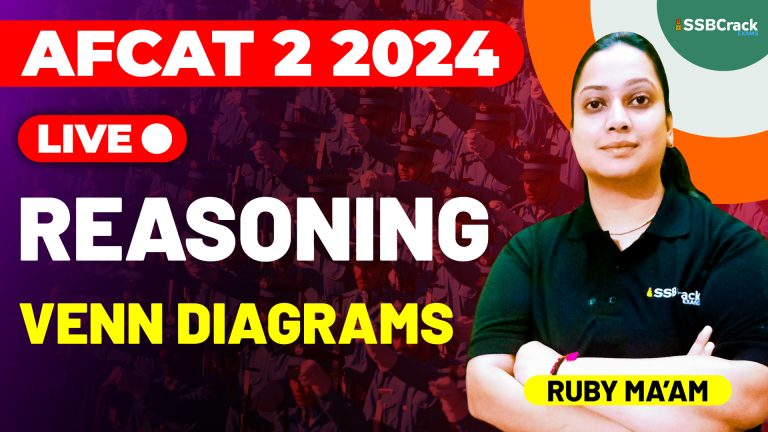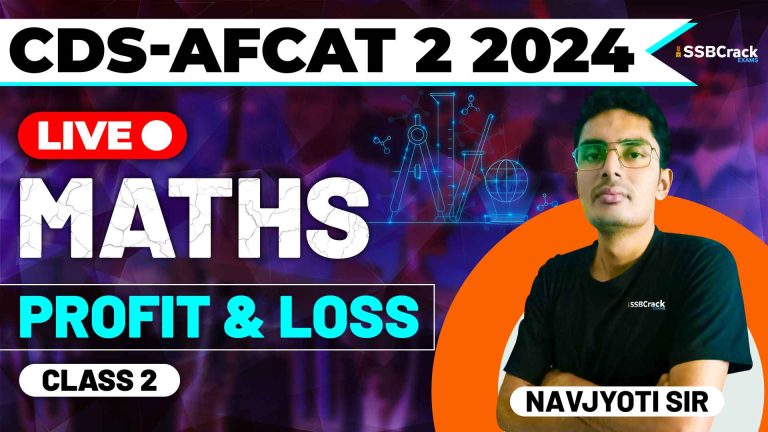In the pursuit of a career in the Indian Air Force and other branches of the Indian Armed Forces, the AFCAT (Air Force Common Admission Test) and CDS (Combined Defence Services) exams are crucial milestones. The Reasoning section of these exams is particularly challenging, and one of the key topics within this section is Venn Diagrams. In this article, we will explore the fundamental concepts of Venn diagrams as discussed in a live class for AFCAT-CDS 1 2024 Exam. Covering not only the basic principles but also the application of tricks to solve complex questions, this guide aims to equip aspirants with the skills and insights needed to navigate Venn diagram questions effectively.
Understanding Venn Diagrams
Venn diagrams are graphical representations that depict the relationships between different sets. In the context of competitive exams like AFCAT and CDS, the interpretation of these diagrams is crucial for solving complex problems related to logical reasoning.
Basic Concepts of Venn Diagrams
Understanding the basic components of Venn diagrams is essential for tackling questions in the AFCAT-CDS 1 2024 Exam.
1. Sets and Elements
- A set is a collection of distinct elements.
- Elements are the individual items within a set.
2. Intersection and Union
- The intersection of sets A and B includes elements that are common to both A and B.
- The union of sets A and B comprises all elements present in either A or B or both.
3. Complement
- The complement of a set A, denoted as A’, includes all elements not belonging to set A within a given universal set.
Types of Venn Diagrams
Venn diagrams come in various types, each representing different scenarios of set relationships.
1. Two-Set Venn Diagram
- Represents the relationship between two sets, showcasing their intersection and individual components.
2. Three-Set Venn Diagram
- Illustrates the relationships between three sets, displaying intersections and unique elements.
3. Overlapping and Non-Overlapping Sets
- Overlapping sets have common elements, while non-overlapping sets do not share any elements.
Solving Venn Diagram Questions with Tricks
Venn diagram questions often involve intricate relationships between sets. Employing tricks can simplify the process of solving these questions.
1. Visualizing Overlapping Sets
- When sets overlap, focus on the regions of overlap. This area represents elements common to both sets.
2. Utilizing Universal Set Information
- Understand the concept of a universal set. Elements outside the boundary of all sets belong to the universal set.
3. Using Complement Information
- Complement information helps identify elements outside a particular set. Leverage this knowledge to deduce relationships.
4. Break Down Complex Diagrams
- For complex diagrams, break down the problem into smaller, manageable parts. Solve each part individually and combine the results.
Examples of Venn Diagram Questions
Let’s explore some real-world examples to illustrate the application of Venn diagrams in competitive exams:
Example 1: Two-Set Venn Diagram
- In a survey, 80 people like tea, 60 like coffee, and 40 like both. Illustrate this information using a Venn diagram.
In this scenario, the two sets are tea and coffee. The overlap represents people who like both tea and coffee, and the non-overlapping regions depict those who like only one of the beverages.
Example 2: Three-Set Venn Diagram
- In a group of 120 students, 50 study Physics, 40 study Chemistry, 30 study Biology, 20 study Physics and Chemistry, 15 study Physics and Biology, 10 study Chemistry and Biology, and 5 study all three subjects. Create a Venn diagram to represent this data.
This example involves three sets: Physics, Chemistry, and Biology. The overlapping regions show students studying two or more subjects, and the non-overlapping regions represent students focused on a single subject.
Strategies for Venn Diagram Problem-Solving
Effectively approaching Venn diagram questions requires a systematic strategy.
1. Understand the Question
- Carefully read and comprehend the question. Identify the sets involved and the relationships described.
2. Identify Given Information
- Note down the information provided in the question. Distinguish between shared and unique elements in each set.
3. Start with Overlapping Regions
- If sets overlap, begin by determining the elements in the intersection. This step is crucial for solving complex problems.
4. Work from the Inside Out
- When dealing with complex diagrams, start solving from the inside regions (intersections) and gradually move outward.
5. Verify with Complement Information
- Ensure that the sum of elements in all regions corresponds to the total number of elements in the universal set.
Common Pitfalls and How to Avoid Them
Avoiding common pitfalls is essential for accurate problem-solving in Venn diagrams.
1. Overlooking Complement Information
- Neglecting complement information can lead to errors. Be mindful of elements outside the sets being considered.
2. Misinterpreting Overlapping Regions
- Clearly understand the nature of overlapping regions. Misinterpretation can result in incorrect deductions.
3. Neglecting Universal Set Boundaries
- Pay attention to the boundaries of the universal set. Elements outside these boundaries are not part of the problem.
4. Rushing Through Complex Diagrams
- For intricate diagrams, take your time. Rushing can lead to confusion and mistakes.
Conclusion
In conclusion, mastering Venn diagrams is crucial for success in the Reasoning section of the AFCAT and CDS exams. Understanding the basic concepts, recognizing different types of diagrams, and applying tricks to solve questions efficiently are essential skills. By visualizing relationships, utilizing complement information, and breaking down complex problems, candidates can navigate Venn diagram questions with confidence. Practice, attention to detail, and a systematic approach will contribute to success in this aspect of logical reasoning. Best of luck in your preparation for the AFCAT-CDS 1 2024 Exam!
















